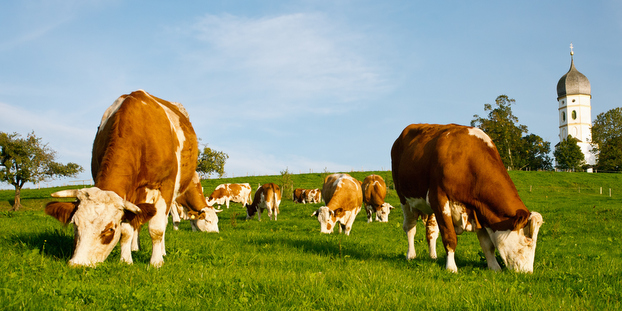
As we noted last week, the Food and Drug Administration has proposed a rule that will increase the regulatory scrutiny on animal feed. Why this matters for a craft brewing industry website is the rule’s application to the spent grain that craft brewers ship out to local farms to feed livestock. Under the rule, this process would need to involve several layers of risk assessment and recordkeeping.
This animal feed rule is really the second FDA proposed rule to look at spent grains in the brewing process as part of its Food Safety Modernization Act rulemaking. The first rule, “Current Good Manufacturing Practice and Hazard Analysis and Risk-Based Preventive Controls for Human Food,” touched on spent grains in January 2013.
In that rule, the FDA looks to establish preventive controls for human food that focuses on preventing problems that can cause foodborne illness. The proposed rule, which is required by the FDA Food Safety Modernization Act, would apply to many domestic and foreign firms that manufacture, process, pack or hold human food. These firms would be required to have written plans that identify hazards, specify the steps that will be put in place to minimize or prevent those hazards, identify monitoring procedures and record monitoring results and specify what actions will be taken to correct problems that arise.
The list of exempt companies does not exclude breweries from following the Current Good Manufacturing Practices (CGMP) portion of the rule. Under the rule, the CGMP regulation would be modified to clarify that certain existing CGMP provisions requiring protection against contamination of food also require protection against cross-contact of food by allergens.
The Beer Institute has not commented on the Animal Feed rule proposal but it did team up with the American Malting Barley Association (AMBA) to pen a comment letter Nov. 25, 2013, concerning this Human Food FDA rule proposal. From that letter:
We fully appreciate that FDA has a separate proposed rulemaking relating to animal food, and we do intend to respond to that rulemaking; nevertheless, because FDA included a discussion about “spent grains” in the current rulemaking, it is appropriate to consider whether there exists any compelling health or safety reason to regulate brewers’ spent grains in the first place. There is no such compelling reason to impose burdensome health or safety regulations on brewers.
Within that letter there are some interesting nuggets that would seem to also apply to the Animal Feed rule proposal. We encourage you to read the whole thing, but some highlights include:
The mere act of separating insoluble particulates from the wort during brewing amounts to a separate manufacturing process and transforms an exempt activity into a non-exempt activity. … [this] proposed interpretation is flawed because it assumes that there is a compelling need to treat the natural by-products or residue of brewing as regulated food.
The goal of brewing is not to manufacture beer and animal feed simultaneously. The goal of brewing is to manufacture beer. Spent grain comes into existence as the result of a necessary step in the brewing process, not as a discrete manufacturing objective. …
The same premium, high food-grade grain used to produce beer is the same grain that results in brewers’ spent grain. It makes no sense to exclude the handling and distribution of those grains while the brewery is using it to produce beer, yet deny that brewery the benefit of the exemption once the grain is spent. Setting the exemption aside mid-stream in the brewing process is illogical from both a regulatory and production standpoint. It is likewise illogical to impose regulation on an otherwise exempt activity simply because a third party (e.g, a farmer or rancher) sees value in the byproducts or residue of the exempt activity.
On the amount of spent-grain in question…
In 2012 alone, U.S. brewers ended up with approximately 2.7 million tons of wet brewers’ spent grain as a necessary by-product or residue of brewing beer.
If the FDA imposes expensive regulations on brewers with respect to brewers’ spent grain, some brewers may have no choice but to landfill their spent grain to minimize expenses. They would lose the income associated with selling their spent grain, and while the cost of landfilling is likely less than the cost of complying with other unnecessary regulatory requirements, should all brewers elect to landfill their spent grain, landfill and transportation costs could easily exceed $210 million per year.
On the nutrition of spent grain…
Farmers and ranchers see brewers’ spent grain as a valuable feed additive for ruminants such as beef and dairy cattle, or for other livestock, including pigs, poultry, goats and horses. By adding brewers’ spent grain, farmers and ranchers can offset the per bushel cost of feed and reduce overall feed costs significantly. The nutritional properties of brewers’ spent grain have also been long understood. Although the composition varies with the particular barley variety, brewers’ spent grain contains moisture, cellulose, proteins and lipids or fats. Brewers’ spent grain has a high content of total digestible nutrients due to the digestibility of the available fiber. This high concentration of fiber is because the starches and sugars are removed from the barley grain during the malting process leaving mainly the structural cell wall carbohydrates of cellulose and hemicellulose. Brewers’ spent grain provides ruminants with needed fiber and a significant amount of protein, which for dairy cattle leads to higher milk and milk protein production than alternative protein sources such as soybean meal. Farmers and ranchers also find greater feed efficiencies with brewers’ spent grain as compared with soybean meal and urea for beef cattle.
Regulation of brewers’ spent grain is not necessary to protect public health, because the safety risk of brewers’ spent grain is exceedingly low. There has not been a single reported human illness or fatality directly linked with brewers’ spent grain.
The associations note that brewers have food safety and quality assessments built into the entire brewing process, from barley purchasing; to storage of barley grains at the grain elevators; to the malting process ending with shipment to its customers.
Any grains that would be of concern to FDA would not be used in the malting process because they would have insufficient germination vigor and therefore could not generate quality malt suitable for brewing. To retain germination vigor, malting barley must also be stored at a low temperature and moisture, further reducing any potential concerns.
And the grand finale, the letter includes a chart to illustrate the total costs that could be associated with suddenly implementing a bunch of risk analysis and record-keeping procedures that could also apply to the provisions in the Animal Feed rule. Keep in mind, the Beer Institute represents the entire beer industry. Your potential compliance doomsday expenses might not hit these thresholds, but the expense categories are real and something to consider:
Regulation of brewers’ spent grain will cost the industry millions of dollars in annual compliance costs, millions in disposal costs, and many millions of dollars in lost revenue without improving public health and safety. The following [table] illustrate the likely substantial financial impact of these rules on a domestic brewer for a single brewery location.
|
Table I –Estimated Financial Impact – Expense Categories Descriptions |
Average Costs Range |
|
Employee Training |
$101,088 |
|
Installation of Cleaning and Monitoring Systems and Infrastructure |
$3,200,000 |
|
Transfer Lines Cleaning |
$336,960 |
|
Waste Water Treatment and Sludge Removal |
$675,000 |
|
Loss of Brewhouse Throughput |
$1,400,000 |
|
Cleaning and Sanitation |
$1,944 |
|
Sampling and Testing |
$6,574,356 |
|
Design Modification of Spent Grain Silo and Scanning System for Spent Grain Collection |
$160,000 |
|
Standard Operating Procedures (SOP) Development |
$58,320 |
|
Systems Monitoring |
$5,832 |
|
Specifications Development |
$19,440 |
|
Verification and Validation Audits |
$1,109,334 |
|
Issuance of Certificate of Analysis (COA) and Truck Wash Certificates |
$3,888 |
|
Issuance Letter of Continuing Guarantee (LOG) |
$0 |
|
Contractual Agreement with Farmers Regarding Receipt of Brewers’ Spent Grain |
$0 |
|
Total Costs |
$13,646,162 |





Spent grain regulation: Commentary from the Beer Institute – Craft Brewing Business http://t.co/uSymojLwR7 @CraftBrewingBiz
This is a HUGE issue for brewers. I hope the entire industry can actively fight this governmental overreach,… http://t.co/8iIuQBJG1I
Spent grain regulation: Commentary from the Beer Institute – Craft Brewing Business http://t.co/Oma77BUSyP via @craftbrewingbiz #craftbeer
Hey #vtbeer brewers, are you giving your spent grain to feed livestock? FDA is set to regulate via http://t.co/kRRZEUZbvz
Ed Malnar liked this on Facebook.